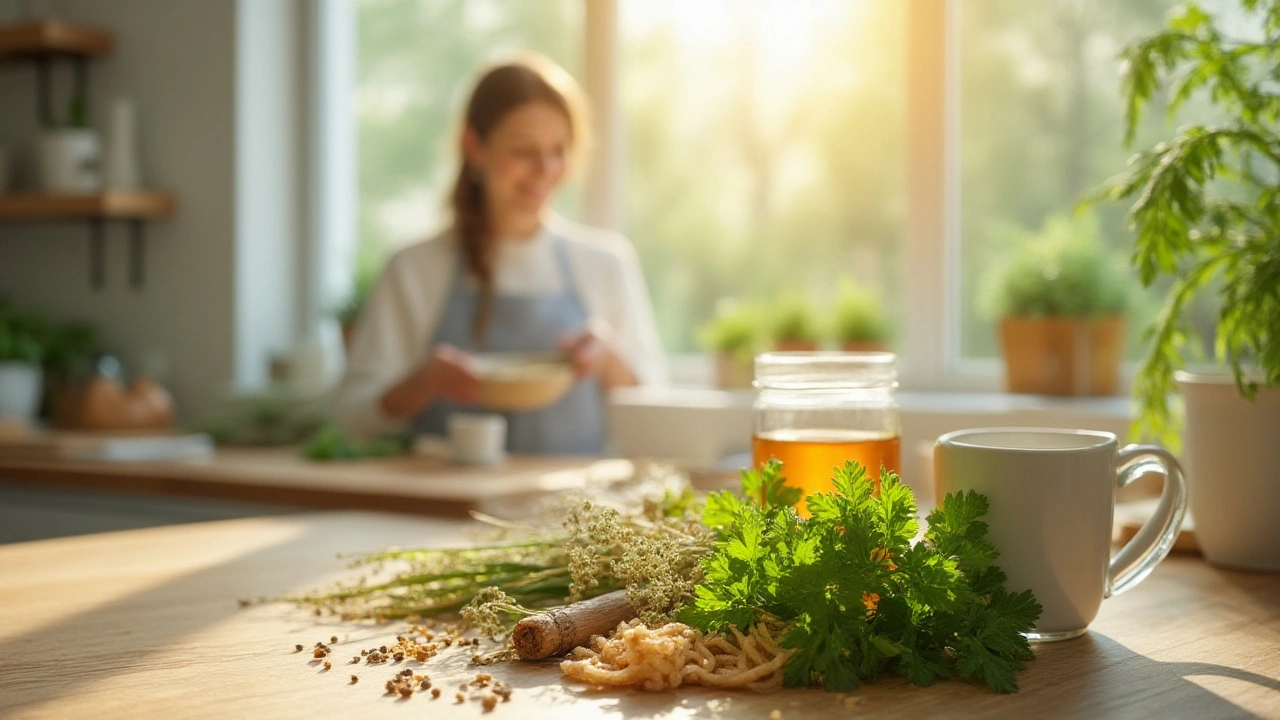Natural Alternatives to Pyridium: Evidence-Backed Bladder Pain Relief Options in 2025
 Jul, 7 2025
Jul, 7 2025
Sharp, burning pain every time you pee. That’s the cursed calling card of bladder irritation—whether from a urinary tract infection or something else, it disrupts everything. Anyone relying on Pyridium for relief knows how effective that little orange tablet feels, but what if you can’t get it or simply want another way? The truth: nature has options, and science is finally catching up with grandma’s old cures. Researchers have started confirming that several herbal remedies and lifestyle tweaks can actually reduce bladder pain, not just mask it.
Understanding Bladder Pain and When to Seek Natural Alternatives
Most of us are all too familiar with the misery of cystitis, UTIs, or just chronic bladder irritation. Bladder pain can hit anyone, but women, especially, are in the front row—thanks, short urethra biology! Typical causes include infections, interstitial cystitis (IC), stones, or irritants like caffeine or acidic foods. Pyridium, also called phenazopyridine, works as a local anesthetic for urinary tract discomfort. But Pyridium is meant for short bursts—a few days, usually while antibiotics kick in. It won’t cure an infection, and it sometimes causes side effects from orange pee to stomach upset. Some folks can’t take it because of allergies, pregnancy, or chronic kidney issues.
That’s why people are turning to natural options. A study from the European Association of Urology in 2023 showed over 40% of patients with recurring bladder pain sought alternative treatments, especially when standard meds caused problems or didn’t help enough. Let’s clear something up: if you have severe pain, fever, blood in your urine, or suspect a kidney infection, you always need proper medical care. But if you’ve been through the UTI gauntlet before—or you suffer low-level, nagging discomfort—there are now proven, gentle options to try in place of Pyridium.
Herbal Remedies With Real Evidence for Bladder Pain Relief
The herbal aisle can be overwhelming, with promises flying left and right. Which of these potions actually help? It’s not all hype—some stand up to the evidence. Let’s run through the best-studied herbal options:
- Uva Ursi (Bearberry): Used for ages in Europe and Africa, this shrub’s leaves have an active ingredient called arbutin that gets transformed in your urine to antibacterial compounds. A 2022 review in the journal "Phytotherapy Research" found uva ursi reduced symptoms in uncomplicated UTIs and lowered recurrence rates, particularly when used at the first twinge of discomfort.
- Horsetail (Equisetum arvense): This old-school remedy is a mild diuretic, helping flush out bacteria and reduce soreness. In a German trial, a horsetail tea used twice daily gave notable pain relief for women with mild bladder discomfort, with hardly any side effects reported. The silica and flavonoids inside seem to be responsible.
- D-Mannose: Not a herb, but a natural sugar found in things like cranberries and apples. D-Mannose sticks to E. coli bacteria—the usual suspects in UTIs—so they get flushed out instead of attaching to your bladder wall. A UK study in 2024 gave D-Mannose to women with recurring UTIs and saw a 57% reduction in infection rates compared to a placebo. Some even use it as a daily preventative.
- Corn Silk (Zea mays): That stringy stuff you toss from fresh corn cobs is packed with plant compounds that soothe inflammation and boost urine flow. Animal studies and limited human data show noticeable pain reduction after one to two weeks of daily corn silk tea.
- Cranberry Extract: The best-known of all for urinary tract health. But here’s the catch: juice often doesn’t contain enough PACs (proanthocyanidins) to help. A 2023 meta-analysis found standardized cranberry extracts could lower UTI recurrence for women, offering mild pain relief as well.
Many women in South Africa (myself included) rely on rooibos tea in times of bladder upset, and while this herbal infusion is antioxidant-rich and gentle on the tummy, formal research is still emerging. Whatever you try, it’s wise to watch for allergic reactions and double-check herbal choices if you’re pregnant or on regular meds.

Lifestyle Changes Backed by Science to Soothe Your Bladder
If there were an Olympic medal for peeing at the first sign of discomfort, many bladder warriors would already have gold. Fun aside, certain habits make a genuine difference in managing pain and reducing flare-ups.
- Hydrate Strategically: The old advice of “drink more water” absolutely helps—up to a point. Too much water can flush electrolytes, but steady sips throughout the day keep urine diluted and less irritating. Tracking your intake and aiming for 2 liters daily is the sweet spot according to bladder health researchers at University of Cape Town.
- Eat Bladder-Friendly Foods: Spicy meals, artificial sweeteners, caffeine, citrus, and alcohol are notorious offenders for flare-ups. Try a log to see what your unique triggers are. Substituting with gentle, alkaline-promoting foods like oats, sweet potatoes, and pears can ease irritation. There’s real data showing a Mediterranean-style diet helps reduce systemic inflammation, helped along by lots of olive oil, greens, and nuts.
- Pee When Needed—Don’t Hold It: Holding urine sets the stage for bacteria. Regular bathroom breaks (every 2–3 hours) get things moving. Double voiding—peeing, standing or sitting for a few minutes, then trying again—can help fully empty the bladder, especially for people with chronic complaints.
- Switch Up Your Personal Care: Fragranced soaps, bubble baths, and some feminine hygiene products mess with your natural flora and pH. Going fragrance-free and letting the area breathe (cotton undies, loose clothing) makes a real difference.
- Heat Therapy: Something as humble as a warm pack on your lower belly can help distract those pain sensors in your pelvic nerves—old advice, but studies from the Cochrane Review in 2023 still say it lowers perceived pain in UTI patients.
- Stress Management: Nobody wants to hear it, but psychological stress directly affects your bladder. Techniques like mindfulness, gentle yoga, or a simple breathing exercise can reduce pain episodes, especially for folks with interstitial cystitis.
Using a combo of these habits almost always works better than relying on just one. The more you know your triggers—and act early—the less likely you are to end up sweating it out on the bathroom floor.
Where to Start: A Practical Guide to Trying Natural Alternatives
Let’s face it: switching from proven meds like Pyridium to less familiar options can feel risky, especially when pain rules your life. But building up a “toolbox” of healthy habits and go-to herbs sets you up for more control in the long run. Here’s how you can get going without getting lost:
- Track your specific bladder pain triggers. Is it always after spicy meals? During your cycle? After sex or exercise? Keeping a diary makes patterns jump out and helps fine-tune future prevention.
- Try one herbal option at a time for at least a week. Whether it’s uva ursi, D-mannose, or cranberry, monitor your body’s reaction carefully. Don’t mix too many remedies at once—you want to know what’s working or not.
- Layer lifestyle changes. Swap caffeinated drinks for water or rooibos, use a hot pack when symptoms flare, and up your veggie intake for a gentle anti-inflammatory approach.
- Reach for evidence first. Not all natural alternatives are created equal. Stick with the ones that have studies behind them—like those listed earlier or sourced from trusted medical sites. For more options, check out this guide to a natural alternative to Pyridium that explains recent clinical evidence.
- Talk to your doctor or pharmacist. Especially important if you take other meds, have kidney or liver issues, or are pregnant. They’re usually happy to help you make safer choices. You might even find options your regular doc didn’t think to mention.
Sometimes, a mix of these approaches brings the best relief. Most importantly, having a plan on hand lowers the anxiety that can make any pain feel worse.
| Remedy | Main Benefit | Supported Uses | Research Status |
|---|---|---|---|
| Uva Ursi | Antibacterial, reduces UTI recurrence | Early UTI, recurrence prevention | Clinical studies, meta-analyses |
| Horsetail | Diuretic, reduces pain | Mild pain, general irritation | Small trials, folk use |
| D-Mannose | Flushes E. coli | UTI prevention, mild relief | RCTs, systematic reviews |
| Corn Silk | Soothes inflammation | Chronic soreness | Animal and human data emerging |
| Cranberry Extract | Prevents recurrence | Recurrent UTI | Multiple meta-analyses |
Real relief from bladder pain doesn’t always require a prescription. By using the right herbal and lifestyle strategies, you can sidestep the frustration that comes with repeated urinary woes. It’s all about having options, tuning into your body, and knowing when to reach for what. Turns out, grandma’s remedies and modern science finally have something in common: they can work better than you think.

Rekha Tiwari
July 13, 2025 AT 13:50Leah Beazy
July 14, 2025 AT 14:30John Villamayor
July 14, 2025 AT 20:07Jenna Hobbs
July 16, 2025 AT 02:08Ophelia Q
July 17, 2025 AT 11:35Elliott Jackson
July 18, 2025 AT 06:51McKayla Carda
July 19, 2025 AT 15:14Christopher Ramsbottom-Isherwood
July 20, 2025 AT 06:31Stacy Reed
July 21, 2025 AT 18:30Robert Gallagher
July 23, 2025 AT 01:11Howard Lee
July 23, 2025 AT 20:32Nicole Carpentier
July 25, 2025 AT 13:49Hadrian D'Souza
July 26, 2025 AT 02:43Brandon Benzi
July 27, 2025 AT 04:15Abhay Chitnis
July 28, 2025 AT 00:18Robert Spiece
July 28, 2025 AT 09:36Vivian Quinones
July 28, 2025 AT 17:56Eric Pelletier
July 29, 2025 AT 15:10Marshall Pope
July 29, 2025 AT 20:16Nonie Rebollido
July 30, 2025 AT 21:40